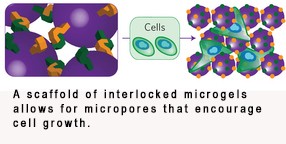
Image courtesy of T. Segura et al, UCLA.
Some skin wounds, such as diabetic ulcers, are chronic and may never heal; others, such as burn wounds, are often large and difficult to treat, resulting in pain, infection, and scarring. Researchers at the University of California, Los Angeles (UCLA), funded by the National Institutes of Health (NIH), have developed a synthetic biomaterial that fills wounds and aids in regeneration of skin cells, which ultimately improves wound healing.
In a study published in the online edition of Nature Materials, the researchers reported that the new biomaterial is compatible with human stem cells and showed that it accelerated healing of wounds in mice.
The skin is an organ system at the interface between our complex anatomy and the often harsh elements of the environment. Normally, wounds in the skin trigger a rapid, orderly, and effective healing process. But serious wounds that span too great an area, such as burns, or that occur in patients with compromised health conditions, such as diabetes and immobility, complicate skin wound healing. Millions of people in the United States are affected by skin wounds that resist repair.
Traditional treatments for such wounds often involve water-based dressings, called hydrogels. While effective in keeping the wound bed hydrated and as a barrier to infection, currently available hydrogels do not provide the physical support for new skin at the critical first stages of the healing process. The UCLA researchers addressed this problem with a reformulated hydrogel incorporating microporous annealed particles (MAPs)-tiny synthetic spheres that adhere to each other. MAPs create a strong scaffold that allows cells to colonize and begin making new skin. They also enhance blood vessel growth to supply sufficient nutrients for rapid healing.
The idea of a porous scaffold is not new, according to the study’s senior author, Tatiana Segura, PhD, associate professor of chemical and biomolecular engineering at UCLA’s Henry Samueli School of Engineering and Applied Science. “Researchers in the field have known for some time that an interconnected microporous network allows for rapid cellular infiltration into the material without having to degrade it,” she said.
But her work provides a different twist that solves a biochemical limitation. Previous methods for forming the interconnected network resulted in a material that could not take the shape of the wound; thus pores formed in the product that were not completely interconnected. “The MAP technology is able to overcome this limitation by binding building blocks to each other, leaving behind an interconnected porous network,” Segura said.
This building block approach provides an added benefit in that the MAP gel’s degradation rate can be tuned to the individual wound bed and so provide a tailored healing platform. Thus, it avoids problems of inadequate support for new tissue from degrading too quickly or scarring from degrading too slowly.
In laboratory tests with human stem cells, the researchers showed that their method formed a porous scaffold with extensive cell networks within just two days, and the scaffold promoted skin growth over the course of one week. In contrast, skin cells that the researchers provided with a similar chemical and mechanical environment-but that was not porous-did not form a cellular network.
The researchers next used the MAP gel to dress the wounds of mice. In a five-day test, 40 percent of wounds with porous MAP gel closed, while none of the wounds treated with nonporous gel closed. In a seven-day test, the wounds of mice treated with porous gel closed 40 percent of the time, while just 20 percent of the wounds of untreated mice and fewer than 10 percent of wounds treated with nonporous gel closed. The researchers noted that the promotion of scaffold by MAP gel even began forming a hair follicle and sebaceous gland.
“I love this Goldilocks approach-not too much, not too little, but just what is needed,” said Rosemarie Hunziker, PhD, program director for Tissue Engineering and Regenerative Medicine at the National Institute of Biomedical Imaging and Bioengineering (NIBIB), part of NIH.
“Every wound site is unique,” wrote the study authors, referring to physical and chemical properties that encourage regeneration of tissues within a wound. They observed that MAP scaffolds may offer a new “landscape of tissue regeneration” that is porous, injectable, and can be assembled in modules.
The research team’s next step is to further validate their results in studies with larger animals. The authors have launched a company, Tempo Therapeutics, to pursue commercialization of the wound-healing technology.
For an animated video of microporous gel scaffolds, visit www.youtube.com/watch?v=MwWlqF0OVww.
This article was based on information provided by the NIBIB.




